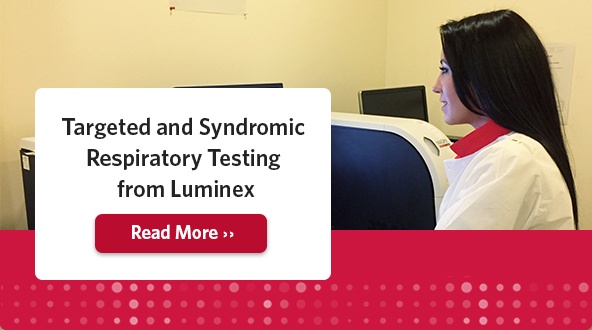Test replaced LDT, offering better ease of use and more comprehensive targets

At the Royal Infirmary of Edinburgh Clinical Virology Department, respiratory testing can be a full-time task. As part of the NHS Lothian Laboratory Medicine, the group covers all aspects of viral testing for Edinburgh and surrounding areas, and also serves as a referral lab for other regions of Scotland. The lab receives a total of 100,000 samples and runs 1 million tests per year, with approximately 30,000 of those samples involving respiratory assays.
Peak Season Can Be Demanding
At times, the respiratory needs were so demanding that lab experts realized something had to change. Respiratory testing used to be performed with a laboratory-developed test involving four separate multiplexes to detect a total of 10 targets, recalls Biomedical Scientist Jenny Dove. During peak season, the lab receives about 200 samples each day. “You’d need four full plates on four machines twice a day,” she says. “We were constantly aliquoting samples. It was a lot of hands-on work and you never felt like you got a break.” Last winter, demand for respiratory testing was so high that the lab simply could not process all of the samples. To get through, they ran full panels¬¬ on the highest-risk cases — patients from hospitals or nursing homes, or children — and reduced panels on everyone else. “We definitely needed another platform that would look at all these targets, ideally with one machine and everything in one well,” Dove says.
NxTAG®—Everyone’s Favorite Assay
The lab’s leadership opted for the NxTAG® Respiratory Pathogen Panel (RPP), which simultaneously detects 20 viral and bacterial pathogens known to cause respiratory infections. It was designed to accommodate high-throughput pipelines and was a natural fit for NHS Lothian’s virology group. Dove, who handled the validation process, tested about 120 samples with the NxTAG RPP test. She said she found “excellent agreement” between [NxTAG] and their in-house assay. For 14 targets, there was 100% agreement.
The NxTAG RPP assay was implemented in March 2018 and it has made a noticeable difference for lab staff. “It’s nearly everyone’s favorite assay,” Dove said. “You just add one sample to one well. It’s so much simpler than our old assay and there’s much less chance of error.” Compared to the LDT, NxTAG RPP involves faster setup, incorporates more targets, is very user-friendly, and improves interpretation with automated results. “Everyone who’s been trained on it absolutely loves it,” she added. The team opted to change the extraction process used for all samples to match the protocol recommended by Luminex and found that the new workflow was much simpler and faster.
Today, Dove and her team can complete and report results from two daily runs by 5 p.m., a full two hours earlier than with the previous test. “It’s much easier and less stressful,” she said. “You don’t feel trapped at the bench now.” Now that NxTAG RPP is in place, the group plans to get back to running full panels for all samples that come in, even during the height of flu season. “We’re able to test more samples faster,” Dove said. “The whole process is much quicker and smoother.”
Related Resources
- In Dublin, Reference Lab Ramps Up Respiratory Testing with NxTAG® RPP [Blog]
- NxTAG® Respiratory Pathogen Panel Product Information [Web page]
- NxTAG® Respiratory Pathogen Panel (US-IVD) [Video]
- In Study, NxTAG® Respiratory Pathogen Panel Yields Strong Data and Clinical Utility Content [Blog]
- View Syndromic and Targeted Molecular Testing Options [Web page]
